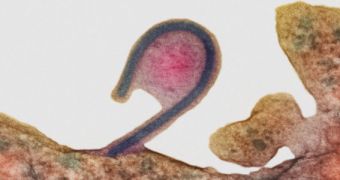West Africa is currently plagued by an Ebola outbreak, but researchers may soon be able to address it via a new compound. According to a team of researchers from the US Army Medical Research Institute for Infectious Diseases (MRIID) lab in Frederick, Maryland, the drug BCX4430 may be able to address this often-fatal condition with success. Clinical trials are scheduled to begin next year.
The research group, led by investigator Travis Warren, says that this would be among the first compounds created to address the Ebola virus disease, or Ebola hemorrhagic fever. The condition is characterized by fever, headaches, and throat and muscle pains. Symptoms usually occur between 2 days and 3 weeks following exposure to the Ebola virus.
Shortly thereafter, follow-on symptoms include vomiting, nausea, and diarrhea, accompanied by a reduction in the ability of the liver and kidneys to perform their respective functions. Bleeding, or hemorrhage, sets on after this stage and accounts for most fatality caused by this condition. Around 68 percent of all patients infected with this virus will die as a direct result.
In order to severely reduce these numbers, or maybe even turn one of the most dreaded viruses in the world into nothing more than a nuisance, the MRIID team has developed BCX4430. Warren has been working on testing and refining this compound for many years, and he and his group are convinced that the drug is now ready for a trial run in humans.
Big pharmaceutical companies have never had an interest in developing a cure against Ebola, because its incidence is so rare in general, and particularly in the developed world. As such, it made no economic sense for these corporations to engage in costly research that would have brought them no profit. However, smaller, government-funded companies are pursuing cures for this condition.
At this point, around six different types of cures against Ebola are being pursued, relaying on various approaches to attack the virus. These range from standard viruses to custom antibodies and conventional drugs. This multi-pronged approach increases the chances that one of the proposals would work, says the director of the National Institute of Allergy and Infectious Diseases (NIAID), Dr. Anthony Fauci.
“I think it's really too early to make a prediction about what is the more or less promising one among them,” the official says, quoted by NPR. The NIAID is part of the US National Institutes of Health.
Warren says that BCX4430 is one of the most promising candidates currently in the race. “It worked great against both Ebola virus and [the closely related] Marburg virus” in mice models, the expert says. The compound has also proven successful in protecting guinea pigs from yellow fever.
In a series of experiments conducted on monkeys infected with the Marburg virus, animals that were given the drug between 24 and 48 hours after infection fared best. None of the monkeys in this group died from the virus as a result, boosting hopes that a similar trend will be observed in humans as well.

 14 DAY TRIAL //
14 DAY TRIAL //